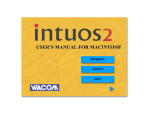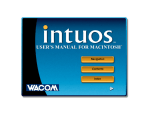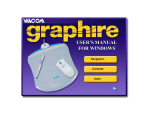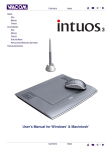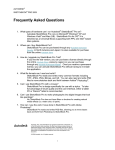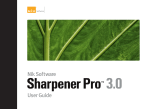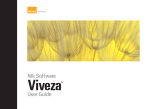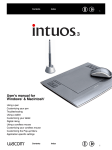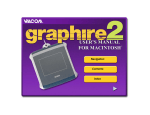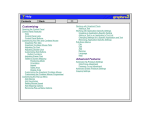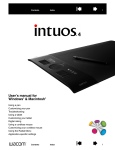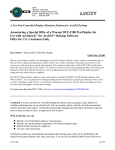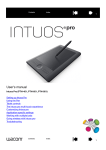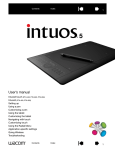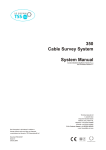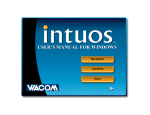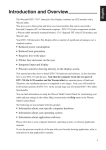Download WACOM Intuos - 2 Help Guide
Transcript
Help Contents Back Customizing Opening the Control Panel Control Panel Features Tabs Control Panel Lists Control Panel Buttons Customizing Your Tools Pen and Airbrush Tabs 2D Mouse and 4D Mouse Tabs Customizing Pen and Airbrush Settings Adjusting Tip Feel Adjusting Double-Click Customizing Tool Buttons Button Functions Airbrush Settings Adjusting Eraser Feel Customizing Tilt Sensitivity Customizing Mouse Tool Settings Customizing the 2D Mouse Customizing the 2D Mouse Fingerwheel Customizing the 4D Mouse and Lens Cursor Programming the 4D Mouse and Lens Cursor Creating a Button Box Customizing the 4D Mouse Fingerwheel Tablet to Screen Mapping Positioning Mode Orientation Aspect Tablet Area Display Area >> Customizing the Pop-up Menu Add Macros Add Keystrokes Setting Mouse Speed Add Mapping Options Removing Pop-up Menu Options Customizing Tablet Buttons Working with Multiple Tools Adding a New Tool Using More Than One Tool Working with Application-Specific Settings Creating an Application-Specific Setting Adding Additional Tools to an Application’s Tool List Changing Settings for a Specific Application and Tool Removing Application-Specific Settings Checking Your USB Tablet Mode Pull-Down Menus File Edit Add Remove Language Help Advanced Features Advanced Tip Pressure Settings Click Force Adjustment Pressure Curve Adjustment Advanced Eraser Pressure Settings Copying Settings Using DualTrack Advanced Mapping Help Contents Back << >> OPENING THE CONTROL PANEL To open the control panel in OS X: 1. In the FINDER, select the GO menu and choose APPLICATIONS. 2. Open the WACOM folder and double-click on the tablet icon. To open the Wacom control panel, double-click here with the tool you wish to customize. To open the control panel in OS 8 and 9: Open the control panel with the Intuos2 tool you wish to customize. 1. Using your Intuos2 tool, open the Apple menu and choose CONTROL PANELS. 2. Double-click on the tablet icon. Help Contents Back << >> CONTROL PANEL FEATURES Use the Wacom control panel to customize your Intuos2 Professional Graphics Tablet. The Pull-Down Menus access many control panel features. The Application List displays applications with customized settings. These buttons add an application or tool to the lists at the left. The Help button displays online Help. The Tool List displays tools that are customized for the above selected application. Tabs display settings for the selected application and selected tool. Tab buttons apply only to the selected tab. Help Contents Back << >> TABS The tabs allow you to customize your Intuos2 tablet and tools. When you open the control panel with an Intuos2 tool, the tool is automatically selected in the TOOL LIST and the appropriate tabs are displayed. If the TOOL LIST has more than one tool, you can select a different tool to customize and the appropriate tabs will display for that tool. These tabs are displayed for the Intuos2 Pen or Airbrush. Note: The APPLICATION LIST is for advanced users; it is not necessary to select or add applications to customize your Intuos2 tool(s). Help Contents Back << >> Tab buttons apply only to the selected tab: • To set the currently open tab to its factory default values, click • If you have changed settings on a tab and want to return the tab to the last state when the control panel was opened, click • To copy settings from one tool or application to another, click Copy Settings To... dialog box. This will display the As you explore the control panel tabs, experiment with different settings to find what works best for you. You can always click RESET TAB TO DEFAULT to return to the factory settings. Or, click REVERT TAB to return a tab to the last state when the control panel was opened. Refer to Customizing Your Tools for detailed information on working with tabs. Help Contents Back << >> CONTROL PANEL LISTS Located in the upper portion of the control panel, the APPLICATION LIST and TOOL LIST allow you to create different tablet and tool settings for individual applications. For example, you might set your pen tip for a soft feel in Painter and a firm feel in all other applications. The APPLICATION LIST displays applications that have custom tool settings associated with them. The TOOL LIST displays tools that can be customized for the application selected above. Click to add an installed application to the APPLICATION LIST. You can customize tool settings for the selected application. Your current selections are highlighted. Wedges emphasize the relationship between tab settings and the selected tool and application. Click to add an Intuos2 tool to the TOOL LIST. You can customize the tool for the above selected application. Help Contents Back << >> • When you first install your Intuos2 Professional Graphics Tablet, the APPLICATION LIST displays the ALL APPLICATIONS icon. This contains tablet and tool settings for all of your applications. • The TOOL LIST displays an icon for each Intuos2 tool that has been used on the tablet. Each Intuos2 tool that is used on the tablet will automatically appear in the Tool List. However, the Wacom control panel settings must be saved before a tool is permanently added to the list. See Adding a New Tool for more information. When you are ready to create custom settings for individual applications, see Working with ApplicationSpecific Settings. CONTROL PANEL BUTTONS The control panel buttons are common to the entire control panel. • To exit the control panel, either click on the close box (located on the window title bar), or select QUIT or CLOSE from the FILE menu. • To display online Help for the control panel, click down menu. Or, you can choose HELP... from the HELP pull- Balloon Help, which provides quick information and useful tips, is also available for most control panel items. To access balloons, turn them on by selecting SHOW BALLOONS from the HELP menu. Help for individual dialog boxes is available by clicking on the button in the specific dialog box. Help Contents Back << >> CUSTOMIZING YOUR TOOLS To change tool settings, open the control panel using the tool you wish to customize. The tool will automatically be selected in the TOOL LIST, and the appropriate tabs will be displayed. To customize settings for a different tool, select it from the TOOL LIST by clicking on its icon. Note that the POP-UP MENU, TABLET BUTTONS, and TABLET MODE tab settings are not tool-specific and changes apply to all tools. PEN AND AIRBRUSH TABS If the selected tool is an Intuos2 Grip Pen or Airbrush, the following tabs are displayed: 2D MOUSE AND 4D MOUSE TABS If the selected tool is a 2D Mouse or 4D Mouse, the following control panel tabs are displayed: Help Contents Back << >> CUSTOMIZING PEN AND AIRBRUSH SETTINGS Customizing your Wacom input tool is easy. First open the Wacom control panel using the tool you wish to customize. The tool will be selected in the TOOL LIST, and the appropriate tabs will be displayed. Select a tab and change settings using the available options. To customize settings for a different tool, select it from the TOOL LIST by clicking on its icon. ADJUSTING TIP FEEL ADJUSTING DOUBLE-CLICK CUSTOMIZING TOOL BUTTONS ADJUSTING ERASER FEEL CUSTOMIZING TILT SENSITIVITY Help Contents Back << >> ADJUSTING TIP FEEL To adjust the sensitivity of your Intuos2 Pen or Airbrush tip, select the TIP FEEL tab. To create broad brush strokes or to click with a light touch, use a soft tip setting. For maximum control while drawing thin lines, use a firm tip setting. A checkmark appears when advanced settings are in effect. Toggles to the advanced options display. Drag the slider to a softer or firmer setting. Make several pen strokes to test the current pressuresensitivity setting. Click here with your pen tip to test the current click pressure setting. Note: For all screen shots of tabs, the tab buttons are omitted in order to save space. Help Contents << Back >> ADJUSTING DOUBLE-CLICK Double-clicking with the pen tip can be made easier by expanding the tap area that accepts a double-click (the double-click distance) and reducing the speed required to perform a double-click. This can be set in the DOUBLE CLICK tab. Because a large double-click distance may adversely affect your brushstrokes in some drawing applications, Wacom recommends setting a small double-click distance and using the lower side switch to double-click. Use custom double-click settings when checked. Note: DOUBLE-CLICK ASSIST can be enabled for some applications and disabled for others. See Working with Application-Specific Settings for more information. Enter a number from 1 to 25 pixels or click the up and down arrows to increase or decrease double-click distance. Drag the slider to change the double-click speed. A slower speed makes double-clicking easier. Double-click on the target to test your settings before applying them. Tap twice on this icon with your pen tip to automatically set double-click distance and speed based on the way you normally double-click. Help Contents Back << >> CUSTOMIZING TOOL BUTTONS Select the TOOL BUTTONS tab to change the functions assigned to the eraser, side switch, and tip of your Intuos2 Pen or Airbrush. If you are using an airbrush, you can also customize the fingerwheel sensitivity. For each tool button, a pull-down menu enables you to choose the function that will be performed. Select the function to perform when using the eraser. Select the function to perform when pressing the upper side switch. Select the function to perform when pressing the lower side switch. Click here to change the function assigned to the pen tip. The tip must be set to click in order to draw in most graphics applications. Help Contents Back << >> Button Functions Each button has a pull-down menu that allows you to choose the function that will be performed when the button is pressed. The following list describes all available functions. However, some options are not available for all buttons or tools. • CLICK. Default setting for the Intuos2 Pen or Airbrush tip. This option simulates a mouse button click. Be sure at least one button performs this function so you can always navigate and click. • DOUBLE-CLICK. Default setting for the lower position of the side switch. When this option is selected, pressing the switch simulates a mouse button double-click. For easier double-clicking, use this function instead of tapping twice with your pen or airbrush tip. • CLICK-LOCK. Simulates holding down the mouse button. Press the tool button once to initiate click lock. Press the button again to release click lock. Click lock is useful for dragging objects or selecting blocks of text. Help Contents • Back << >> KEYSTROKE.... Enables you to simulate a series of keystrokes. When you select this option, the DEFINE KEYSTROKE dialog box appears. There, you can enter a keystroke or keystroke sequence to play back. Keystroke combinations can include letters, numbers, function keys (such as F3) and modifier keys (such as SHIFT, OPTION, COMMAND, and CTRL). After defining a keystroke sequence, click OK. Important: Because the RETURN key can be selected as a defined keystroke, it cannot be used to select OK. You must use a tool to click on the OK button. Help Contents • Back << >> MODIFIER.... Enables you to simulate modifier key(s) (such as SHIFT, OPTION, COMMAND, and CTRL). Many applications use modifier keys to constrain the size or placement of objects. If you select this option, the DEFINE MODIFIERS dialog box appears. There, you select the modifier key(s) to simulate. You can select the CLICK box plus one or more modifier key options to define the function you want your tool button to simulate. Help Contents • Back << >> MACRO.... Enables you to play a macro sequence. When you select this option, the SELECT MACRO dialog box appears. There, you can select a predefined macro to play back. After selecting a macro, click OK. Choose the macro type. Select the macro you wish to use. Note: Before you can add macros, you must first create them with a third-party macro application, such as QuicKeys. Help Contents Back << >> • PRESSURE HOLD. Sets a button so that, when pressed, the pressure is locked at the current pressure level until the button is released. For example, you can paint with pressure-sensitivity until you reach the brush size that you like. You can then press the button and continue painting with the same size brush until the button is released. • MODE TOGGLE.... Toggles between Pen Mode and Mouse Mode. When first setting a tool button to MODE TOGGLE..., the MOUSE SPEED dialog box is displayed where you can adjust the mouse acceleration and speed. Sets the screen cursor speed when in MOUSE MODE. Sets the screen cursor acceleration when in MOUSE MODE. Note: Mouse speed settings can be accessed from a number of different locations within the control panel. However, for each input tool and application that you are customizing, only one MOUSE SPEED and ACCELERATION setting can be made. Help Contents Back << >> • POP-UP MENU. Displays a Pop-up Menu on your screen. See Customizing the Pop-up Menu for more information. • ERASE. Default setting for the eraser. • IGNORED. (Intuos2 Pens and Airbrush only.) Disables the button function. • APPLICATION DEFINED. (2D Mouse, 4D Mouse, or Lens Cursor only.) Only the button number is reported to your application. Use this setting when using applications that have built-in support for tool buttons. For example, CAD programs that support tablets can assign their own functions to a button. Help Contents Back << >> Airbrush Settings The Intuos2 Airbrush is equipped with a drawing tip, a fingerwheel, a single side switch, and an eraser. Button functions are set in the same manner as with the Intuos2 Pen. Additionally, the fingerwheel sensitivity range can be customized to suit your preference. MAXIMUM is the default setting, and requires you to move the wheel over its full range to achieve maximum effect. INTERMEDIATE requires a medium amount of wheel movement to achieve maximum effect. MINIMUM requires the least amount of wheel movement to achieve maximum effect. In supporting applications, the fingerwheel can be used to control ink flow, brush size, opacity, or other variables. Reducing the fingerwheel range allows you to achieve the same effect with less finger movement. Move the wheel forward for less effect and move it back for more effect. Visit Wacom’s web site for a list of applications that currently support airbrush features. Help Contents Back << >> ADJUSTING ERASER FEEL To adjust the sensitivity of your Intuos2 Pen or Airbrush eraser, select the ERASER FEEL tab. To erase with a broad stroke or to click with a light touch, use a soft tip setting. For maximum control while erasing, use a firm eraser setting. A checkmark appears when advanced settings are in effect. Toggles to the advanced options display. Drag the slider to a softer or firmer setting. Using your eraser, test the current eraser pressure-sensitivity setting by erasing here. Check the eraser click pressure setting by using the eraser to select and delete this text. Help Contents << Back >> CUSTOMIZING TILT SENSITIVITY To adjust the tilt sensitivity of your Intuos2 Pen or Airbrush, select the TILT tab. Tilt sensitivity controls how far you have to tilt the tool to produce the maximum tilt effect in your application. You need to tilt the pen less at high sensitivity than at low sensitivity to get the full tilt value reported to your application. Like pressure-sensitivity, tilt can be assigned to control brush characteristics. Your tilt setting applies to both the tip and eraser of your pen or airbrush. Drag the slider to increase or decrease pen tilt sensitivity. The default setting is LESS. The tilt display graphically shows the reported tilt angle of your pen or airbrush. Place your pen or airbrush vertically on the tablet, and tilt it from side to side and forward and backward. The graphic lever moves to indicate the amount and direction of tilt reported to the application. Note: Tilt is direction-sensitive and can be used in some applications to control brush orientation. Visit Wacom’s web site for a list of applications that currently support tilt. Help Contents Back << >> CUSTOMIZING MOUSE TOOL SETTINGS Customizing your Wacom input tool is easy. First open the Wacom control panel using the tool you wish to customize. The tool will be selected in the TOOL LIST, and the appropriate tabs will be displayed. Select a tab and change settings using the available options. To customize settings for a different tool, select it from the TOOL LIST by clicking on its icon. CUSTOMIZING THE 2D MOUSE CUSTOMIZING THE 2D MOUSE FINGERWHEEL CUSTOMIZING THE 4D MOUSE AND LENS CURSOR CUSTOMIZING THE 4D MOUSE FINGERWHEEL Help Contents << Back >> CUSTOMIZING THE 2D MOUSE To modify your 2D Mouse button settings, select the TOOL BUTTONS tab. Select the function to perform when pressing a button. You can select a function to perform for each button from the button pull-down menus. Refer to Button Functions for a description of the available options. The 2D Mouse buttons are chordable; you can press two or more buttons simultaneously and the functions will occur. For example, if you program one button to simulate the Ctrl key and another to simulate a Z keystroke, when you press both buttons a Ctrl+Z is simulated. Help Contents << Back >> CUSTOMIZING THE 2D MOUSE FINGERWHEEL To customize your 2D Mouse fingerwheel, choose the FINGERWHEEL tab. Sets the fingerwheel to scroll the selected number of lines for each notch of fingerwheel movement (in most applications). Enter a value (1 to 15) to set the amount of movement. Roll the fingerwheel forward to scroll up, and back to scroll down. Disables the fingerwheel function. Sets the fingerwheel to scroll one screen for each notch of fingerwheel movement. When checked, the functions assigned for the forward and backward direction of the fingerwheel are exchanged. The KEYSTROKES radio button sets the fingerwheel to issue a keystroke for each notch of wheel movement. This is useful when working with repetitive functions (such as zooming in Photoshop, or moving forward and backward within your internet browser). Click the appropriate SET... button to enter a keystroke function. The keystroke setting will be displayed in the UP or DOWN box. Help Contents Back << >> CUSTOMIZING THE 4D MOUSE AND LENS CURSOR To modify your 4D Mouse and Lens Cursor button settings, select the TOOL BUTTONS tab. As with the Intuos2 Pen and Airbrush, you can select a function to perform for each button from the button pull-down menus. Refer to Button Functions for a description of the available options. Select the function to perform when pressing a button. When checked, the 4D Mouse or Lens Cursor functions as a Button Box. See Creating a Button Box. Help Contents Back << >> Programming the 4D Mouse and Lens Cursor The 4D Mouse and Lens Cursor buttons are chordable; you can press two or more buttons simultaneously and the functions will occur. For example, if you program one button to simulate the CTRL key and another to simulate a Z keystroke, when you press both buttons a CTRL+Z is simulated. Creating a Button Box You can check the BUTTON BOX option to disable cursor tracking when using the 4D Mouse or Lens Cursor. This gives you the freedom to draw with the pen without having to reach for the keyboard to enter a keystroke. Instead, you might press the 4D Mouse or Lens Cursor buttons to perform defined keystroke functions. Note that if you use your 4D Mouse or Lens Cursor as a Button Box, it must remain on the tablet’s active area to function. Help Contents Back << >> CUSTOMIZING THE 4D MOUSE FINGERWHEEL To customize your 4D Mouse fingerwheel, choose the FINGERWHEEL tab. Sets the 4D Mouse fingerwheel for scrolling functionality. Roll the fingerwheel forward to scroll up, and back to scroll down. Sets the fingerwheel sensitivity. With MAXIMUM selected, a small movement of the fingerwheel will create a large effect. With STANDARD selected, a small movement of the fingerwheel will create a small effect. Provides fingerwheel information to a supporting application. Some applications may use the fingerwheel for 3D navigation, zooming, audio or video jogging, etc. The KEYSTROKES radio button sets the fingerwheel to issue repeated keystroke events to the application. You can adjust the rate of repetition by how far you move the fingerwheel forward or backward. This is useful when working with repetitive functions (such as zooming in Photoshop or moving forward and backward within your internet browser). Click the appropriate SET... button to enter a keystroke function. The keystroke setting will be displayed in the UP or DOWN box. When checked, the functions assigned for the forward and backward direction of the fingerwheel are exchanged. Simulates pressure. Move the fingerwheel forward or backwards to increase pressure. Disables the fingerwheel. Help Contents Back << >> TABLET TO SCREEN MAPPING To change the relationship between tool movement on your tablet and cursor movement on the screen, select the MAPPING/SPEED tab. The default POSITIONING MODE for Intuos2 Pens and the Airbrush is PEN MODE, which means that each point on the tablet maps to a corresponding point on the screen. In PEN MODE, the MAPPING/SPEED tab looks like this: Positioning Mode. In PEN MODE, the screen cursor moves with absolute positioning. Select the Orientation of your tablet. Note: Except for tablet orientation, all mapping settings apply to a specific Intuos2 tool. Select the Tablet Area for drawing. Display Area. Select a monitor area for tablet to screen mapping. Aspect. Select a tablet to screen mapping relationship. QuickPoint Mode. “Splits” tablet into two independent areas: a large area for drawing and a small area for quick navigation. Both areas are mapped to the display area. Click here to display Advanced Mapping options. Help Contents Back << >> The default POSITIONING MODE for the 2D Mouse, 4D Mouse, and Lens Cursor is MOUSE MODE. With MOUSE MODE selected, the MAPPING/SPEED tab looks like this: Positioning Mode. In MOUSE MODE, the screen cursor moves with relative positioning. Select the Orientation of your tablet. Sets the screen cursor acceleration when in MOUSE MODE. Select a slower or faster screen cursor speed when in MOUSE MODE. Help Contents Back << >> POSITIONING MODE The POSITIONING MODE controls how the screen cursor moves. • In Pen Mode, wherever you place an Intuos2 tool on the tablet, the cursor jumps to the corresponding point on the screen. This is the default setting for Intuos2 Pens and the Airbrush, and is required for tracing. • In Mouse Mode, the screen cursor is positioned like a mouse, requiring a “pick up and slide” motion to move the cursor on the screen. This is the default setting for the 2D Mouse, 4D Mouse, and Lens Cursor. By default the pen and airbrush are set to PEN MODE for drawing, and the 2D Mouse and 4D Mouse are set to MOUSE MODE for navigation. Note: You can also switch between Pen Mode and Mouse Mode by clicking on the appropriate tablet button, or by using the screen Pop-up Menu. See Customizing Tablet Buttons and Customizing the Popup Menu for more information. Help Contents Back << >> ORIENTATION If you want the tablet menu buttons on the side or the bottom of your tablet, or if you are working with a tall monitor, you can rotate the tablet to one of the following orientations: • LANDSCAPE. Tablet orientation is horizontal, with tablet buttons at the top. This is the default setting. • PORTRAIT. Rotate the tablet 90 degrees clockwise from landscape orientation. The tablet orientation will be vertical, with the tablet buttons on the right side. • LANDSCAPE FLIPPED. Rotate the tablet 180 degrees from landscape orientation. The tablet will be upside down, with the tablet buttons near the bottom. • PORTRAIT FLIPPED. Rotate the tablet 90 degrees counter-clockwise from landscape orientation. The tablet orientation will be vertical with the tablet buttons on the left side. After making changes, verify you have the correct setting for your tablet orientation. Do this by moving your tool “up” on the tablet—the cursor should move up as well. Note: The orientation you select applies to all tools and applications. Help Contents Back << >> ASPECT Aspect defines the constraints of the tablet to screen relationship. ASPECT options include: • ONE TO ONE. Sets a 1:1 scale between the tablet and the display. Moving your tool one inch on the tablet will move the cursor one inch on the screen. A traced image appears the same size as the original image on your display screen. A screen resolution of 72 DPI is used in calculations. If your monitor is set to use a different screen resolution, a 1:1 scale will not be maintained. • PROPORTIONAL. Maintains correct vertical and horizontal proportions between the tablet and display. A traced image appears proportionally correct on your display, but may be smaller or larger than the original image. • TO FIT. Correct scale or proportions are not maintained. The selected tablet area is mapped to the selected display area. A traced image may appear stretched, and may be smaller or larger than the original image. This is the default setting for all tools. Help Contents Back << >> TABLET AREA These settings allow you to define the tablet area that will be mapped to the display area. Uses the entire active area of the tablet for tablet to display mapping. This is the default setting. Displays the PORTION OF TABLET dialog box where you can select a portion of the tablet’s active area for tablet to display mapping. Divides the tablet into a drawing area and a QuickPoint area for quick navigation. (For Intuos2 9x12/A4-regular and larger tablets.) Sets the QuickPoint area to the lower right corner of the tablet. Sets the QuickPoint area to the lower left corner of the tablet. Help Contents • Back << >> PORTION OF TABLET. Enter coordinates to select the tablet area. • • Select UNITS of measure for the displayed values. A count equals one line of tablet resolution. Enter values for the TOP, LEFT, BOTTOM, and RIGHT boundary of the tablet area. Values are measured from the top left corner of the tablet’s active area. Drag corners of the foreground graphic to select the tablet area. The background graphic represents the entire active tablet area. Values in the ENTER COORDINATES text boxes change accordingly. Use your tool on the tablet to select the tablet area. • • Select the CLICK TO DEFINE TABLET AREA button. Follow the MESSAGE prompts to set the portion of your tablet that will be used for mapping. Note: As you define PORTION OF TABLET, be sure to review the MESSAGE prompts that may appear. Help Contents • Back << >> QUICKPOINT MODE. This option (available for Intuos2 9x12/A4-regular and larger tablets) divides the tablet into two independent areas: a large area for drawing, and a small area for quick navigation. QuickPoint Mode can also be selected and deselected using the tablet buttons or screen Pop-up Menu. See Customizing Tablet Buttons and Customizing the Pop-up Menu for more information. The QuickPoint area is always mapped to the entire display area (to all monitors on multiple monitor systems). The drawing area is set to Pen Mode and mapped according to the DISPLAY AREA and ASPECT settings. 9x12/A4-regular tablet 9x12/A4-regular tablet 12x12/A4-oversize tablet Drawing 12x12/A4-oversize tablet areas QuickPoint area set to lower left corner of tablet. 12x18/A3 tablet QuickPoint area set to lower right corner of tablet. 12x18/A3 tablet Note: The QuickPoint area and drawing area are indicated by crop marks on the tablet overlay. All QuickPoint and drawing areas have the same aspect as a standard monitor (aspect ratio of 3:4). Help Contents Back << >> DISPLAY AREA The DISPLAY AREA options allow you to define which portion of the display screen your tablet will map to. • ENTIRE DISPLAY. Select this option to access the entire display. This is the default setting. If more than one monitor is in use, a pull-down menu is displayed with options for selecting ALL MONITORS or individual monitors. • PORTION OF DISPLAY.... This option allows you to select a portion of the display for tablet to screen mapping. Selecting PORTION OF DISPLAY... brings up the PORTION OF DISPLAY dialog box. Enter coordinates to select the screen area. • • Select UNITS of measure for the displayed values. Enter values for the TOP, LEFT, BOTTOM, and RIGHT boundary of the display screen area. Values are measured from the top left corner of the display. Drag corners of the foreground graphic to select the screen area. The background graphic represents the entire screen area. Values in the ENTER COORDINATES text boxes will change accordingly. Move the screen cursor to select the screen area. • • Select the CLICK TO DEFINE SCREEN AREA button. Follow the MESSAGE prompts to set the portion of your display screen that will be used for mapping. Note: As you define PORTION OF DISPLAY, be sure to review the MESSAGE prompts that may appear. Help Contents Back << >> CUSTOMIZING THE POP-UP MENU Select the POP-UP MENU tab to customize the available functions on the Pop-up Menu list. The Pop-up Menu list may include predefined macros, keystroke functions, and mapping options. To display the Pop-up Menu, set one of your tool buttons to the POP-UP MENU function. Whenever you push that button, the Pop-up Menu is displayed. Select items in the Pop-up Menu by clicking on them. To close the Pop-up Menu without making a selection, just click outside the Pop-up Menu. Adds a predefined macro to the menu list. Before you can add macros, you must first create them with a third-party macro application. Adds a keystroke macro to the menu list. Displays a list of functions that will appear in the Pop-up Menu. To change the order of an item, drag it to a new location (mapping options are moved as a group). Note: Pop-up Menu settings apply to all tools. Displays the Mouse Speed dialog box where you can set the screen cursor speed and acceleration when in MOUSE MODE. If you remove the PEN, MOUSE, and QUICKPOINT mode options from the menu list, this button is replaced with the ADD MAPPING OPTIONS button, which enables you to add PEN, MOUSE, and QUICKPOINT mode options back to the POP-UP MENU list. The mapping option you select from the Pop-up Menu is applied only to the tool used to select it. Removes the selected item(s) from the list. Help Contents Back << >> ADD MACROS To add a macro to the Pop-up Menu, click on the ADD MACRO... button. A dialog box will appear where you can select the name of a macro function to add. You can also set different macros for different applications. See Working with Application-Specific Settings for more information. Note: Before you can add screen macros, you must first create them with a third-party macro application. ADD KEYSTROKES To add a keystroke definition to the Pop-up Menu, click on the ADD KEYSTROKE... button. A dialog box will appear where you can specify and name the keystroke function. You can also create different keystroke functions for different applications. See Working with Application-Specific Settings for more information. Help Contents Back << >> SETTING MOUSE SPEED To change the screen cursor acceleration and speed when in MOUSE MODE, click on the SET MOUSE SPEED... button (located on the POP-UP MENU tab) to display a dialog box where you can make your adjustments. If you removed the PEN, MOUSE, and QUICKPOINT mode options from the menu list, this button is replaced with the ADD MAPPING OPTIONS button, which enables you to add PEN, MOUSE, and QUICKPOINT mode options back to the Pop-up Menu list. Sets the screen cursor speed when in MOUSE MODE. Sets the screen cursor acceleration when in MOUSE MODE. Note: The MOUSE SPEED dialog box will also appear when you first set a tool button to MODE TOGGLE... from the TOOL BUTTONS tab. For each input tool and application that you are customizing, only one MOUSE SPEED and ACCELERATION setting can be made. Help Contents Back << >> ADD MAPPING OPTIONS Click on the Add Mapping Options button (when visible) to add the following mapping options to the Pop-up Menu list: PEN MODE, MOUSE MODE, and (if you are working with a Intuos2 9x12/A4-regular or larger tablet) QUICKPOINT MODE. REMOVING POP-UP MENU OPTIONS To remove mapping option(s), macro(s), or keystroke function(s) from the Pop-up Menu list, select the function(s) you wish to remove and click the REMOVE button. Mapping options must be added or removed as a single item. Multiple options may be selected for removal by pressing the SHIFT key and clicking on them. Help Contents Back << >> CUSTOMIZING TABLET BUTTONS You can define different tablet button functions for each application, but not for the different Intuos2 tools. To customize the tablet menu strip buttons, select the TABLET BUTTONS tab. By default, tablet buttons with predefined functions have that function selected in their pull-down menu. The settings of other tablet buttons are set to IGNORED. Choose the function to perform when the tablet button is selected. Displays the predefined function or keystroke sequence. Otherwise, this is left blank. To customize tablet button functions: 1. Select the button you wish to customize from the scrolling list. Help Contents Back << >> 2. Select an item from the tablet button’s pull-down menu. • KEYSTROKE. Simulates a keystroke or keystroke combination. • MACRO. Enables you to play a predefined macro sequence. • PRESSURE SOFT. Sets the pressure feel of the pen, airbrush, or eraser to a soft setting. • PRESSURE FIRM. Sets the pressure feel of the pen, airbrush, or eraser to a firm setting. • PRESSURE NORMAL. Returns the pressure feel of your tool to the factory default. • PEN MODE. Places your tool in Pen Mode. • MOUSE MODE.... Places your tool in MOUSE MODE. When first setting a tablet button to MOUSE MODE..., the MOUSE SPEED dialog box is displayed where you can adjust the mouse acceleration and speed. • QUICKPOINT MODE. Divides the tablet into a QuickPoint area and a drawing area. This option is only available for Intuos2 9x12/A4-regular or larger tablets. • IGNORED. Leaves the tablet button undefined. When a tablet button is set to IGNORED, the button number does not appear on the display screen when an Intuos2 tool is moved over the button. • DEFAULT. Returns a button to its default settings. These settings match the predefined menu strip functions. • Back. Sets the button to emulate the back function within your internet browser. • Forward. Sets the button to emulate the forward function with your internet browser. • Stop. Sets the button to emulate the stop function within your internet browser. • Refresh. Sets the button to emulate the refresh function within your internet browser. After defining a new tablet button function, you may want to label the appropriate menu strip button (with 6x8/A5 and larger tablets only). Lift the left edge of the tablet overlay and remove the menu strip. Write the function name on the button with a pencil, and then replace the menu strip. Take care not to damage the overlay or lose the menu strip. Help Contents Back << >> WORKING WITH MULTIPLE TOOLS The Wacom control panel is designed to help you customize and keep track of your Intuos2 tool settings. The tool you use to open the control panel is automatically selected, and the appropriate tabs for that tool are displayed. If application-specific settings have not been added, the ALL APPLICATIONS icon is displayed and the tool settings apply for all applications. The TOOL LIST displays icons for tools that are customized for the above selected application. Tab settings apply only to the selected tool and application. Your current selections are highlighted. Wedges emphasize the relationship between tab settings and the selected tool and application. Help Contents Back << >> ADDING A NEW TOOL When a new Intuos2 tool is placed on the tablet, it automatically appears in the TOOL LIST. However, the Wacom control panel settings must be saved before the tool is permanently added to the list. Whenever a new Intuos2 tool is added it always uses the default settings for that tool, and not the custom settings of other tools, even if they are identical devices. There are several ways to add Intuos2 tools to the TOOL LIST: • When you use an Intuos2 tool on the tablet for the first time, it will automatically function with the appropriate default settings. You can customize the tool by opening the Wacom control panel and changing the tab settings. Your changes are permanently saved when you close the control panel. When you place a second Intuos2 tool on the tablet, a new tool discovered message box appears. This reminds you to open the Wacom control panel to permanently add the new tool to the TOOL LIST. (This message only appears if the Wacom control panel is not open. If the control panel is open, the tool is automatically added to the list.) • To manually add a new tool, click on the ADD TOOL TO LIST... button or select TOOL TO CUSTOMIZE... from the ADD pull-down menu. In the ADD TOOL TO CUSTOMIZE dialog box, select ADD NEW TOOL... and follow the prompts. When you select a new tool that you have added to the TOOL LIST, the appropriate tab settings for that tool are displayed. Any changes you may make to the tab settings will then apply to that tool. To remove a tool from the TOOL LIST, select CUSTOMIZED TOOL... from the REMOVE menu. In the dialog box that appears, select the tool to remove. Then select REMOVE COMPLETELY and click OK. Help Contents Back << >> USING MORE THAN ONE TOOL Each Intuos2 tool features Tool ID, which makes each device unique. Any settings you customize in the Wacom control panel apply only to the specific tool for which they were made. If you have two identical Intuos2 tools, they will appear as numbered devices in the TOOL LIST. You can give each tool a different name. For example, you might name one “Drawing Pen” and the other “Paint Brush”. To change the tool names, select RENAME TOOL... from the EDIT pull-down menu. To use the same custom settings with two tools, click the Copy Settings To... button and choose the settings you want to copy. For dissimilar tools (such as a pen and a 4D Mouse), only those settings common to both tools (such as mapping settings) can be copied. Help Contents Back << >> WORKING WITH APPLICATION-SPECIFIC SETTINGS You may wish to have different tool settings for a particular application. The APPLICATION LIST lets you customize your Intuos2 tablet and tool settings for individual applications. The APPLICATION LIST displays icons for applications with customized settings. The TOOL LIST displays icons for tools that are customized for the above selected application. Tab settings apply only to the selected tool and application. Your current selections are highlighted. Wedges emphasize the relationship between tab settings and the selected tool and application. Help Contents Back << >> If application-specific settings have not been created, a single icon labeled ALL APPLICATIONS is displayed in the APPLICATION LIST, and the tool settings displayed in the tabs are applied to all applications. When a second application is added to the APPLICATION LIST, the ALL APPLICATIONS icon changes to ALL OTHER APPS, and a new icon is displayed for the new application settings. If you select the ALL OTHER APPS icon and make changes to the tab settings, your changes will apply to all applications except the specific one(s) you have added to the list. If you select the icon for a specific application and make changes to the tab settings, your changes will apply to only that application. When ALL APPLICATIONS or ALL OTHER APPS is selected in the APPLICATION LIST, the TOOL LIST displays icons for all Intuos2 tools that have been added to the tool list. When an icon for a specific application is selected from the APPLICATION LIST, the TOOL LIST only displays the Intuos2 tools that have been added for the selected application. When you create an application-specific setting, you are, in a sense, creating a separate TOOL LIST for the application. Help Contents Back << >> CREATING AN APPLICATION-SPECIFIC SETTING To create an application-specific setting, click on the ADD APPLICATION TO LIST... button or select APPLICATIONS FOR CUSTOM SETTINGS... from the ADD pull-down menu. The ADD APPLICATION FOR CUSTOM SETTINGS dialog box appears. Select an application to add to the APPLICATION LIST. Only applications that are currently running and that have not previously been added to the APPLICATION LIST are displayed. BROWSE to select the executable file of any application installed on your computer. Displays the name of the selected application. If you have more than one tablet, select the tablet(s) for which to add applicationspecific settings. Click OK to continue. Note: First customize settings for one application. When you feel comfortable using application-specific settings, you can create more application-specific settings. Help Contents Back << >> If you are working with a single tool, it is automatically added to the TOOL LIST for the application you have added. If you are using more than one tool, the ADD TOOL TO APPLICATION dialog box is displayed. Choose one or more tools to add to the TOOL LIST for this application. By default, the tool in your hand is selected. Click OK to confirm your selection. Lists all tools that can be customized. Note: All tools not selected will continue to work with the settings specified for ALL OTHER APPS. After you have added an application, its icon appears in the APPLICATION LIST. When you select the application icon, the TOOL LIST displays only the tool(s) that have application-specific settings for the application. Any tools that do not appear in the TOOL LIST for the application will use the settings for ALL OTHER APPS. In the TOOL LIST you can select a tool and then use the tabs to change the tool settings. Help Contents Back << >> ADDING ADDITIONAL TOOLS TO AN APPLICATION’S TOOL LIST To add another tool to an application’s TOOL LIST, click on the ADD TOOL TO LIST... button or select TOOL TO CUSTOMIZE... from the ADD pull-down menu. The ADD TOOL TO CUSTOMIZE dialog box appears. Choose the application and tool to create settings for. Click OK to confirm your selection. The dialog box will close, and the tool will appear in the TOOL LIST for the chosen application. If you have more than one tablet, select the tablet(s) for which to add application-specific settings. First select ADD EXISTING TOOL TO APPLICATION. Choose an application. Only applications that have been added to the APPLICATION LIST are displayed. Select a tool. Only tool(s) that have not been added to the TOOL LIST for the selected application are displayed. Help Contents Back << >> CHANGING SETTINGS FOR A SPECIFIC APPLICATION AND TOOL To change settings for a specific application and tool combination, from the APPLICATION LIST choose the application you want to change tool settings for. From the TOOL LIST, choose the tool you want to customize. Change the tab settings for the selected application and tool combination. REMOVING APPLICATION-SPECIFIC SETTINGS To remove application-specific settings: 1. Open the REMOVE menu and select CUSTOM SETTINGS FOR APPLICATION.... 2. In the REMOVE CUSTOM SETTINGS FOR APPLICATION dialog box, select the application(s) for which you want to remove the custom settings and click OK. To remove application-specific settings for a tool: 1. Select CUSTOMIZED TOOL... from the REMOVE pull-down menu. 2. In the REMOVE CUSTOMIZED TOOL dialog box, select the tool to remove. Then click on the REMOVE FROM radio button and select the application that you want to remove the tool from. 3. Click OK to confirm your selections. Help Contents Back << >> CHECKING YOUR USB TABLET MODE If you are working with a USB tablet, select the TABLET MODE tab to check the mode your tablet is operating in. Recommended for graphics applications. Single tool mode at maximum data rate. Required by some handwriting recognition software. In SINGLE MODE, the tablet will support only one input tool. Do not place two tools on the tablet at the same time. Help Contents Back << >> PULL-DOWN MENUS Use the pull-down menus to access additional custom settings options, a language selection menu, and online documentation. Help is available for most dialog boxes that appear when you make a menu selection—just click on the dialog box button for detailed information on settings and options. FILE The File menu contains the following options: • • • SUMMARY.... Provides a summary of your current settings. CLOSE. Closes the control panel and saves any changes. QUIT. Closes the control panel and saves any changes. EDIT The EDIT menu contains the following options: • • • • COPY SETTINGS TO.... Opens a dialog box where you can copy your customized settings to another tool or application. You can also access this dialog box by clicking on the COPY SETTINGS TO... tab button. RESET SETTINGS.... Opens a dialog box where you can reset your customized settings to their factory default values. RENAME TOOL.... Opens a dialog box where you can assign custom names to your tools. PREFERENCES.... Opens a dialog box where you can change general Intuos2 operating preferences. Help Contents Back << >> ADD The ADD menu contains the following options: • • • TABLET.... Opens a dialog box where you can add one or more tablets. APPLICATION FOR CUSTOM SETTINGS.... Opens a dialog box where you can add an application to the APPLICATION LIST. This is also accessed by clicking on the ADD APPLICATION TO LIST... button. Refer to Working with Application-Specific Settings for more information. TOOL TO CUSTOMIZE.... Opens a dialog box where you can add a tool to the control panel TOOL LIST. This is also accessed by clicking on the ADD TOOL TO LIST... button. Refer to Adding a New Tool for more information. REMOVE The REMOVE menu contains the following options: • • • TABLET.... Opens a dialog box where you can remove one or more tablets from the control panel driver. CUSTOM SETTINGS FOR APPLICATION.... Opens a dialog box where you can remove custom tool settings from an application. CUSTOMIZED TOOL.... Opens a dialog box where you can remove customized tools. Note: If only one item is available for a particular REMOVE menu option, the option will be dimmed. For example, if you have only one tool the CUSTOMIZED TOOL... option will be dim. Help Contents Back << >> LANGUAGE The LANGUAGE menu allows you to switch between English and other installed languages. The language of the operating system is typically installed when you install the driver, but other languages can be added by running the installer a second time and choosing the additional language. HELP The HELP menu contains the following options: • • • • HELP.... Displays online Help. USER’S MANUAL.... Displays the Intuos2 User’s Manual for Macintosh. GETTING STARTED.... Displays an overview of the control panel. DIAGNOSTICS.... Displays diagnostics information for your Intuos2 tablet and tool(s). Help Contents Back << >> ADVANCED TIP PRESSURE SETTINGS To customize advanced tip pressure settings, from the TIP FEEL tab select MORE OPTIONS. The advanced options enable you to change the click pressure and pressure curve settings independently. (In the basic options display, these settings are adjusted simultaneously with the TIP PRESSURE FEEL slider.) Important: The TIP PRESSURE FEEL slider overrides the advanced pressure settings. If you customize advanced settings, then drag the TIP PRESSURE FEEL slider, your advanced settings will be removed. Use these controls to manually change the pressure curve shape. Toggles to the basic options display. After you set advanced settings, a checkmark appears. Use this area to automatically set the maximum amount of force to use when drawing. Test the results of your changes before you apply them. The pressure curve graphically displays the relationship between force applied to your tool and pressure reported to an application. Help Contents Back << >> CLICK FORCE ADJUSTMENT The click force setting adjusts the amount of force required to generate a button click. The CLICK FORCE bar graphically displays the force level at which a click occurs. Enter a value from 1 to 50% or drag the CLICK FORCE bar to set the force at which a click occurs. Note: For optimal performance in graphics applications, set the click force and minimum tip force to the same value. Help Contents Back << >> PRESSURE CURVE ADJUSTMENT Changing the shape of the pressure curve will change the feel of the pen tip. A pressure curve that increases quickly makes the tip feel more sensitive to changes in force. The control points at each end of the pressure curve set the minimum and maximum amount of force your pen or airbrush will respond to. If you have a soft touch and want to achieve full pressure without having to apply full force to your pen, decrease the maximum force level. You can apply less force to your pen and still have the effects of full pressure. The default for maximum force is 100%. To change curve shape, drag the control point to a new position. Enter a value from 20 to 100%, or drag the MAXIMUM TIP FORCE control to set the maximum force your pen tip will respond to. Enter a value from 0 to 80%, or drag the MINIMUM TIP FORCE control to set the minimum force that will register pressure. Help Contents Back << >> To automatically set the maximum force for the way you draw, click the START OVER button and draw several strokes in the drawing area. As you draw, the MAXIMUM TIP FORCE control moves, and the value in the edit box changes to reflect the peak pressure registered by your hand movements. To start over, click the START OVER button and begin a new drawing. While applying normal pressure to the pen tip, draw several strokes here to automatically set the maximum force value. Click here to reset maximum force value to the start value for this test. Help Contents Back << >> ADVANCED ERASER PRESSURE SETTINGS To customize advanced eraser pressure settings, select the ERASER FEEL tab and click on the MORE OPTIONS button. You work with the advanced eraser settings in the same manner as with the Advanced Tip Pressure Settings. Important: The ERASER PRESSURE FEEL slider overrides the advanced pressure settings. If you customize advanced settings, then drag the ERASER PRESSURE FEEL slider, your advanced settings will be removed. Help Contents Back << >> COPYING SETTINGS To copy settings to another tool or application choose the COPY SETTINGS TO... option from the EDIT menu, or click on the COPY SETTINGS TO... button. A dialog box is displayed where you can copy settings from one tool to another within the same application or between different applications. You can also copy settings between different types of Intuos2 tools. Note: For dissimilar tools (such as a pen and a Mouse), only those settings common to both tools (such as mapping settings) can be copied. However, if you are working with multiple Intuos2 tools of the same type, any or all settings can be copied between them. Choose from where settings will be copied. Select where settings will be copied to. Help Contents Back << >> USING DUALTRACK All Intuos2 tablets support the concurrent use of two Intuos2 tools on a tablet. This feature is called DualTrack. DualTrack will function according to how an application implements support for two input tools. In some applications, two-handed input is used to rotate, size, and position an object by controlling two handles on the object simultaneously. In applications that do not support positional data from two Intuos2 tools, the first tool placed on the tablet will control the screen cursor and the second tool will function as a Button Box. If you are using a graphics program, for example, you can set one of the 4D Mouse buttons to simulate the SHIFT key to constrain lines while drawing. If you place the 4D Mouse on the tablet’s active area while using the pen, the 4D Mouse will not control the screen cursor—only the buttons will function. If you press the 4D Mouse button assigned to the SHIFT function while drawing with the Intuos2 Pen, the line will be constrained as long as the 4D Mouse button is pressed. Note: DualTrack is the default setting for the tablet. When STANDARD mode is selected in the TABLET MODE tab, DualTrack is on. Note also that the 2D Mouse does not support DualTrack. Visit our web site for a list of applications that support DualTrack. Help Contents << Back >> ADVANCED MAPPING The ability to adjust basic mapping features is sufficient for most users. However, if your work demands a high degree of flexibility, you can have additional control over your tablet to display settings by clicking on the ADVANCED MAPPING... button (located on the MAPPING/SPEED tab) to display the ADVANCED MAPPING dialog box. Here, you can define multiple different tablet to screen mappings. Changes units, origin, and range or size displayed in the status bar. Creates a new mapping. Shows only the display area that corresponds to the selected mapping. Removes the active map. Be sure to first select the correct map. Sets scale for PROPORTIONAL or TO FIT aspect ratios. Changes the relative position of maps. Defines the screen area for each tablet mapping. Selects an existing map. You can also click on the map. Defines a tablet area for each mapping. Help Contents Back << >> Before you begin, verify that you have selected the correct application and tool for which you want to create advanced mappings. Then plan your mapping area(s). For example, you may want to define a small area for navigation, and a larger one for drawing. For best results, patiently complete each of the following steps: 1. Set preferences by clicking on the READOUT OPTIONS... button. From the READOUT OPTIONS dialog box, select an option from each pull-down menu. Click OK to confirm your selections. Measurement units can be in inches, mm, points, or counts. Counts are lines of tablet resolution or screen pixels. Starting point where measurements originate, from upper left or lower left corner. Coordinates of the origin and the diagonal corner. Coordinate of the origin and the height and width of the area. 2. Select the tablet mapping to define. The mapping numbers are displayed in the top left corner of each tablet area graphic. If multiple tablet mappings have been defined, click inside the tablet area you want to select or click on the SELECT MAP... button and type the number of the mapping you want to select. Help Contents Back << >> 3. Define the size of the tablet area by dragging the handles of the selected tablet area. Then click and drag the tablet area to the desired position. For more precise control in selecting the tablet area, click the SET TABLET... button to access the Portion of Tablet dialog box. There, you can define the tablet area in a variety of ways. 4. From the ASPECT pull-down menu, select an option. These options work similarly to normal mapping. If you choose PROPORTIONAL or TO FIT, you can set an exact scale factor. Same as normal mapping. • • One to One. A 1:1 scale is maintained between the selected tablet portion and the screen. Proportional. Maintains the correct vertical and horizontal proportions. However, the drawing may display larger or smaller on the screen. To set the scale, click the SCALE button. In the SET SCALE FACTOR dialog box, enter a value to define the tablet to screen ratio. For example, a scale factor of 2 will make two inches on the tablet equal to one inch on the screen. Help Contents • • Back << >> To Fit. Maps the selected tablet area to the selected screen area. The scale and the vertical and horizontal proportions are not maintained. To set the scale, click the SCALE button. In the SET SCALE FACTOR dialog box, enter values to define the tablet to screen ratios for the x and y axes. The ratio between x- and y-scale factor indicates how much a traced image will be distorted by the mapping relationship between tablet and screen. For example, an x-scale factor of 2 makes two inches on the tablet’s x axis equal to one inch on the screen’s x axis. A y-scale factor of 3 makes three inches on the tablet’s y axis equal to one inch on the screen’s y axis. Mouse Mode. Sets the area to position the screen cursor in Mouse Mode. 5. Define the size of the display area by dragging the handles of the selected display area. Then click and drag the display area to the desired position. For more precise control in selecting the display area, click the SET DISPLAY... button to access the Portion of Display dialog box. There, you can define the display area in a variety of ways. 6. To create additional tablet mappings, click on the ADD MAPPING button. A new mapping is created with the entire tablet area mapped to the entire display area. Repeat the above steps to size and position the tablet and display areas for each mapping you add. If you define overlapping tablet areas, the tablet area with a lower number will always be above (in front of) the areas with a higher number and will have precedence for positioning the pointer on the screen. Use the BRING TO FRONT and SEND TO REAR buttons to change the relative positions of the maps. For example, if you have created multiple mappings, SEND TO REAR will move a selected mapping to the “bottom” of the stack. Help Contents Back << 7. Click OK to confirm your changes and close the dialog box. To exit the dialog box without making changes, click CANCEL. Notes: • To remove a mapping, select the mapping to be removed and click on the DELETE MAPPING button. To quickly remove all advanced mappings from a tool, in the MAPPING/SPEED tab, click RESET TAB TO DEFAULT for that particular application and tool. This also resets all MAPPING/SPEED tab settings to defaults. • The advanced mapping settings used for mapping 1 are the settings that will appear under the MAPPING/SPEED tab. • Copying Settings enables you to use your advanced mapping settings for other tools and applications as well.



































































